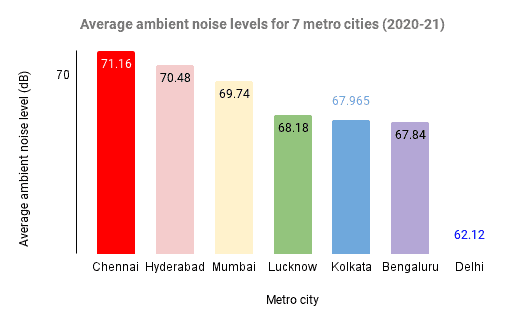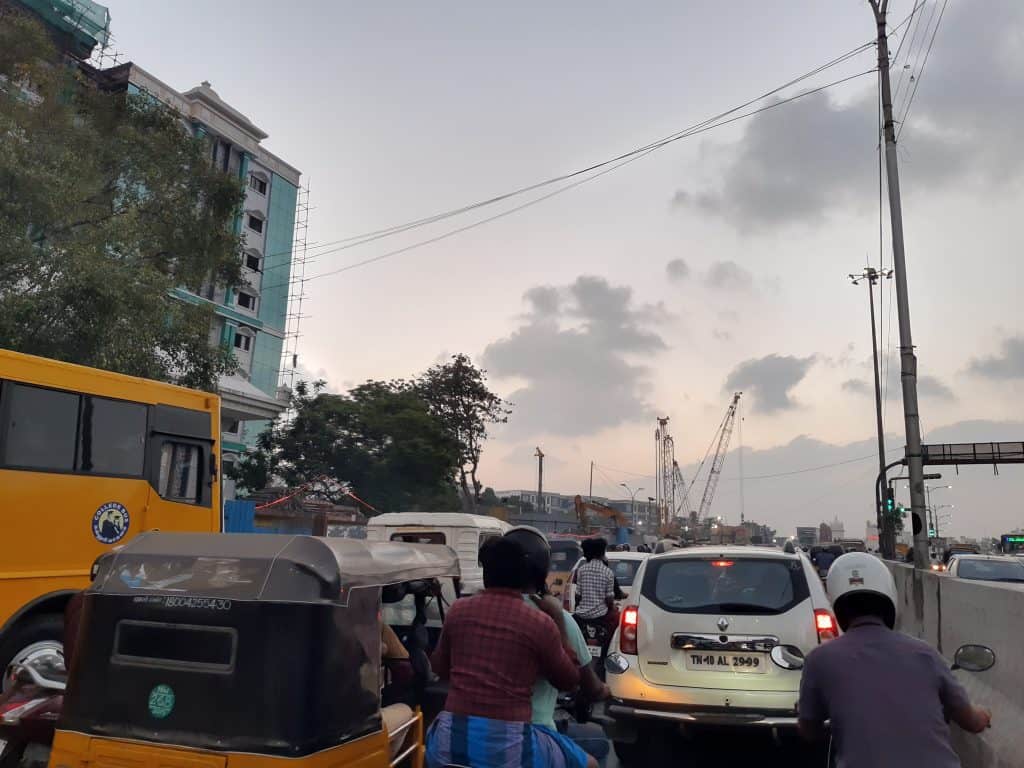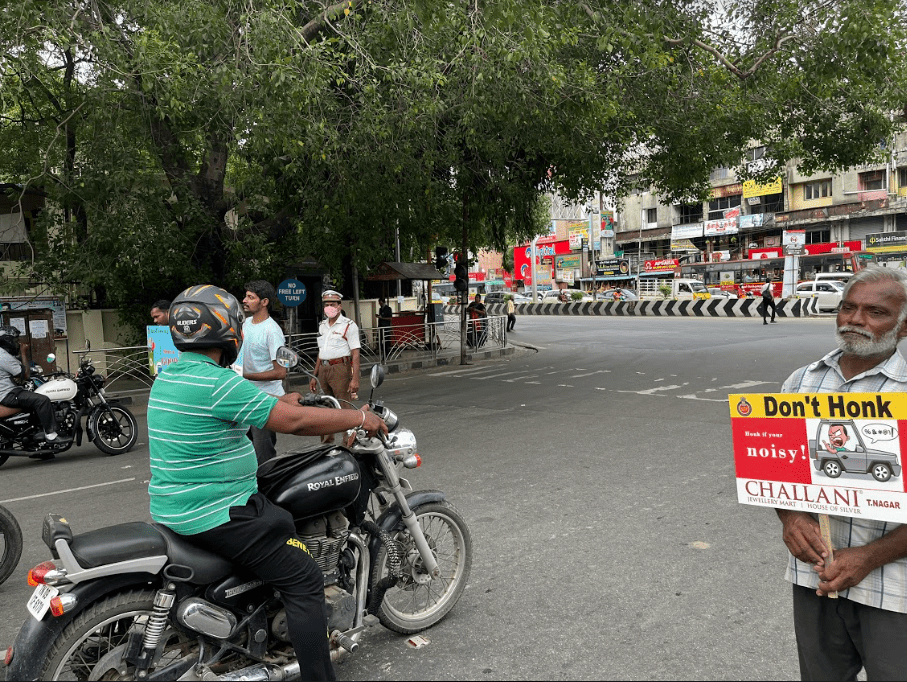If you have felt like Chennai’s streets are turning increasingly cacophonous lately, the belief may not be unfounded. The city has been ranked the noisiest city among seven metros – Bengaluru, Hyderabad, Mumbai, Lucknow, Delhi, and Kolkata by the pollution watchdog, the Central Pollution Control Board (CPCB) of India in their Annual Report 2020-21. Despite this, there is little attention paid to the problem of noise pollution in Chennai.
“Noise pollution does not get the same attention as air pollution or water pollution,” said Prabhakaran Veerarasu, an environmental engineer with the environmental collective Poovulagin Nanbargal. “This is because the impact of air and water pollution are more tangible than noise pollution,” says Dr R Narendran, an ENT specialist from Mandaveli. One can visibly see and smell smoke and water getting polluted to some extent, but the impact of noise pollution takes time to materialise, he added.
Citizen Matters unpacks what noise pollution means and what the safeguards and redressal mechanisms available to the residents are.
Defining noise pollution
Any unwanted sound that irritates human ears is defined as noise, according to CPCB.
“Annoyance caused by the sound is subjective and also based on the duration in which a sound is heard. For instance, a person is exposed to 80 decibels for 6-8 hours will be irritated even when they hear 60 decibels,” said Prabhakaran even as 60 decibels is well within the maximum limits of noise in India. This is why it becomes crucial to add the component of duration while defining noise pollution, he added.
“This definition of noise pollution is human-centric. In an ecosystem, animals also produce and take in sound – be it for mating or hunting. Sound is at the core of their existence,” said Vetriselvan Muthuraj, an environmental lawyer with Poovulagin Nanbargal. He recommended that the definition of noise be made more eco-sensitive.
The decibel requirements of various ecosystems will vary. For instance, a water body and a forest area will have different decibel limits, so it is crucial to decide how many decibels of artificial sound must be allowed in each area, he suggested.
How is noise measured?
Noise is measured in decibels (dB). Decibels measure the sound intensity. They are unlike other measurements like centimetres with regular intervals, where the difference between 30 cm and 10 cm is 20 cm. Decibels are measured exponentially. A 10 dB sound is 10 times louder than near silence at 0 dB, and 20 dB is 100 times louder than near silence at 0 dB.
The permissible noise level varies with zones, according to the Noise Pollution (Regulation and Control) Rules, 2000. The zones are classified as residential, commercial, silent and industrial zones.
Silence zones are spots of 100 metres around hospitals, educational institutions, courts, and religious places.
“Ecosensitive zones and forest areas do not fall under silence zones. They are not included in the noise pollution rules,” noted Vetriselvan.

No noise in public places can exceed 75 dB or 10 dB more than the ambient noise levels, whichever is lower, as per the rules. However, in the periphery of private areas, the noise level cannot exceed 5 dB of the specified limit.
Rating noise pollution in Chennai
The residential, silence, industrial and commercial zones of the Chennai see gross violation of permissible noise levels, as stated in the CPCB Annual Report.
The noise levels of the two silent zones, Egmore Eye Hospital and Anna Nagar stood at 72.8 dB and 65.1 dB respectively, during the day. According to the CPCB, the noise limit for silence zones cannot go beyond 50 dB during the day.


On July 2022, Chennai saw an average noise level of 84.5 dB, as measured by the NGO Young Indians.
Health hazards for the people
Doctors say that persistent exposure to noise above 75 dB can have everlasting effects on the health of a person. “That is the decibel level at which we react comfortably. Anything more than that, can cause physical symptoms like ear pain and headache on continuous exposure. Psychological effects include irritability, anger issues and disturbance in sleep,” said Dr Narendran.
Sound exerts pressure, and loud noises exert greater pressure, which can damage the eardrum and in extreme cases, the inner ear, leading to partial or complete hearing loss. Apart from that the ENT specialist also spoke about how loud noises can affect people with hypertension.
Noise pollution can also give rise to interference in speech, giddiness, and nausea, said Dr Shanthi, a general physician. “Normal humans can hear a frequency of 20 to 20,000 Hz. But this range will reduce with age,” she added.
Humans are not the only living beings affected by noise pollution. A recent study indicated that loud noises can hamper the growth of plants as well.
Urbanisation and traffic an issue
According to a study, rapid urbanisation in cities leads to pollution. The rising population would demand more vehicles and infrastructure, causing more noise pollution, thanks to traffic and construction.
Chennai has undergone rapid expansion in recent years. Ten years ago, the area of the city was 174 sq kilometres, and today it is 426 sq kilometres. Research has predicted that there will be 36% of urban growth in Chennai.
Even as the city grows, scant attention is paid to issues that stem from noise pollution.
Citizen Matters discovered that noise zones – residential, commercial, industrial and silent- were not considered during urban planning. “Take T Nagar for example, it is both residential and commercial. How can one area effectively handle both type of zones with regard to noise pollution? Only if zoning is properly implemented can we control these issues,” said Prabhakaran.

There are three crore private vehicles in Tamil Nadu, with the number having doubled since 2011. Of this, 60 lakh vehicle ply the roads of Chennai and are also a source of noise pollution.
“The major cause of noise pollution in a city, which is undergoing rapid urbanisation, is traffic,” said Prabhakaran. Although construction, industrial and public address systems emanate noise, traffic seems to pose a more sustained threat. “The number of vehicles has been growing and with it comes noise pollution,” said Vetriselvan.
“Traffic-caused noise pollution need not be only because of vehicle horns. It can be because of engines and silencers as well. On busy roads, noise is inevitable,” he added. Even when traffic police check vehicles, the focus is on paperwork and rarely ever about noise pollution.
“The cops mostly check only for the licence, RC book, and insurance for the vehicle. They do not check horns in the two-wheelers,” recollected Prabhakaran. Even when vehicles were very old, they are usually only checked for emissions but not the noise emitted by the engine.
There is also an issue with regards to enforcement of noise pollution norms on city streets that complicates matters further. The Central Motor Vehicles Rules, 1989 contradict the Noise Pollution (Regulation and Control) Rules, 2000, as the permissible noise from vehicular horns mandated by the former is between 93 dB to 112 dB, way beyond the 75 dB cap stated in the latter.
Despite a higher noise limit for horns, people still fit loud horns of 120-150 dB, which is illegal according to the Motor Vehicles Rules “A 120 dB horn is 4-5 times louder than an 80 db horn,” said Prabhakaran. Apart from horns, even illegal silencers are fitted in vehicles, adding to the noise from the engines.
Read more: Chennai survey finds 65% food delivery personnel violated traffic rules
Anti-honking campaign to battle noise pollution
Occasional campaigns have been held in the city to curb noise pollution from vehicles. In 2018, around 23,800 cases were booked for possession of illegal air horns in Chennai, where trucks and buses faced more pushback than two-wheelers.
More recently, to create awareness about the ill-effects of vehicular noise pollution, especially honking, there was an Anti-Honking campaign conducted by the Greater Chennai Traffic Police from June 27 to July 3. Placards reading “Do not honk” were held during signals for motorists to see. Around 2.3 lakhs of people took the “No Honking” pledge during campaign.
From the start of the campaign, the police booked 572 cases against motorists using loud horns, and 281 of them have been removed from vehicles. Modified silencers were also seized. “The campaign, while welcome, could be conducted more vigorously to educate people,” said Vetriselvan.
Although this is a positive move from the authorities to battle vehicular noise pollution, it is vital to look into its impact. There are some motorists who believe that it is impossible to drive without honking. “If we have to go ahead of a motorist, we have to honk. Sometimes I honk while turning left or right to ensure there is no one on the other end,” describes a 21-year-old Naveen Balaji who travels in his scooter almost daily. He believes that the no-honking campaign will not work, as without that it would be difficult to navigate the city.
On the other hand, some have taken no-honking as a challenge. A motorcycle rider, who witnessed the campaign in Ashok Nagar, took it as a challenge to not honk until he reached his office in OMR. While returning in the evening, he told the volunteers of NGO Thozhan, who were part of the campaign, that he had had a peaceful rise as he did not honk.
Construction a source of noise pollution
The local police addresses noise complaints in the city level. In Chennai, there have been instances when many complaints have not been resolved, per aggrieved residents.
A construction site in Thiruvanmiyur inconvenienced residents at around 11 pm mid-July. The police arrived at the site within ten minutes of the complaint by a resident. “The construction stopped for a couple of hours. Then the noise began again around 1 am, and went on till almost 6 am,” said the complainant. Those in the vicinity were unable to sleep for a whole week after the construction work began. The resident was told that the truck to clear debris was allowed to ply only at night.
According to the Noise Pollution (Regulation and Control) Rules, 2000, it is illegal to do work with sound-emitting construction equipment between 10 pm to 6 am in residential and silent zones. “I would rather not disclose any personal details and escalate the issue further. I hear the people who are doing the construction are politically connected,” said the resident.
This is not the only incident in the city where people are afraid to speak up against construction noise violators. In 2021, residents in Mandaveli found themselves unable to sleep at night due to construction activities by a real estate firm. The work was carried out outside of the permissible hours. Even after the local police came and warned them, the work was stopped only for a short time and resumed later. This issue was raised with Tamil Nadu Pollution Control Board, National Human Rights Commission of India, the city police department and CM Cell, but there has been no penal action.
In areas like T Nagar where commercial and residential zones are sandwiched, the construction noise at night is even more common, said Kannan Balachandran, RWA secretary of T Nagar. “Suppose there is maintenance work that has to be done in a commercial establishment like a jewellery shop, they do it at night, and the noises of heavy equipment disturb the neighbouring residential areas,” he said.
Read more: Illegal construction in Chennai: Where are the rules and whom can one report to?
Addressing noise pollution in the city
“The sign of a good driver is that they should not honk,” said Vetriselvan, adding that motorists honk unnecessarily. He called for a change in attitude of people towards honking. “But this should go hand in hand with enhancing public transport, walkability and broadening of roads,” he added.
“Traffic was not considered during urban planning. We need to predict the traffic trends for 30 years before chalking plans in the city in order to mitigate this issue,” said Prabhakaran.
“Electric vehicles can be promoted and used as it emanates very less noise,” said Dr Narendran, when asked about how Chennai can reduce vehicular noise pollution.
Construction of soundproof buildings, following zonal regulations by allotting separate areas for industries and controlling noise in the railway stations, bus stops and airports, are some ways to stem the noise pollution in the city, said Dr Shanthi.
“The noise laws in place are fine,” said Prabhakaran, adding that it is the implementation that must be strengthened. In 2020, the CPCB proposed strict fines from Rs 1000 to Rs 1 lakh for violation of the noise pollution rules. “In the already existing noise laws, we can include a monetary compensation provision for the aggrieved from the violators,” he said.
“Noise pollution is a public nuisance. Violators can be penalised under public nuisance laws. But that does not happen in reality. The city is undergoing more development, and we cannot be lax about noise pollution anymore,” he said.


Padmaja: this is a good informative article. You have not mentioned what resources are available if someone is breaking the ambient noise level. Who should we complain to ? How does the legal system respond to complaints of noise pollution.
vvelpari@gmail.com